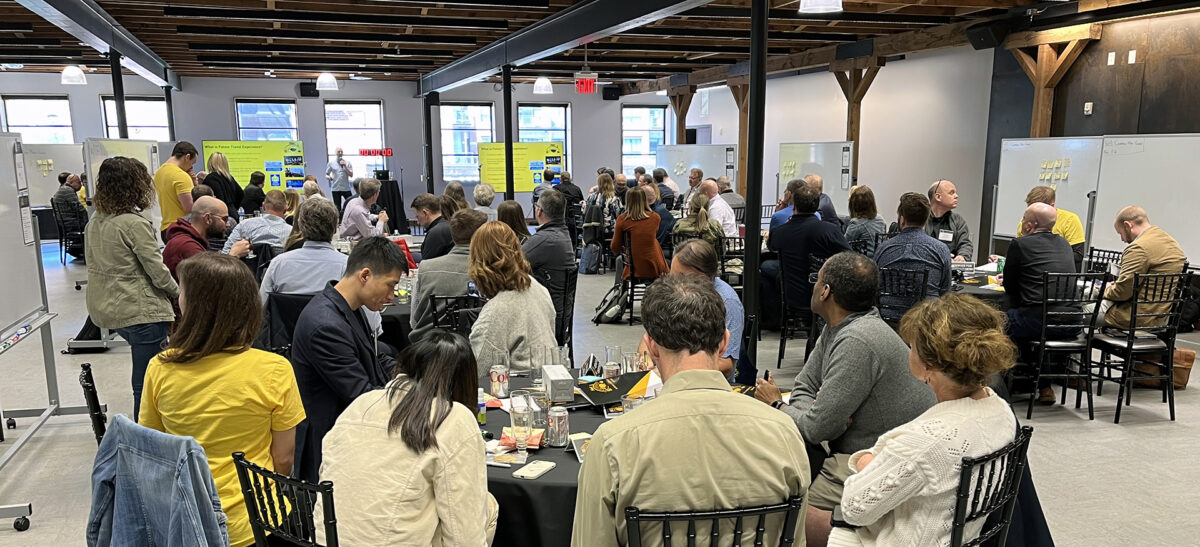When Tech and Aviation Huddle, Creative Sparks Fly
Aviation & Robotics Summit teams pitch investors on industry solutions
By Matt Neistei
Published April 20, 2023
Read Time: 5 mins
What is the biggest challenge in aviation?
If you asked 100 people in the industry that question, you’d get 100 answers—and none of them would be wrong. But ask them how to solve those challenges and, well, the answers probably won’t come as quickly.
Enter the first-ever Aviation & Robotics Summit, a three-day, invitation-only event held in Pittsburgh for international aviation officials and local tech entrepreneurs that focuses entirely on finding those solutions.
“We don’t have to solve all of the problems,” said Mike Formica, managing director of Hardware for Innovation Works, an organizer of the Summit. “We just have to solve some of the problems.”
At the center of the event was a workshop, organized into clusters of experts from aviation and robotics to collaborate on those problems. The sessions were closed to the public to promote trust and confidence among the attendees.

Ashley Bailey, Administrative Coordinator at Pittsburgh International Airport, serves as a facilitator for one of 10 groups at the Aviation & Robotics Summit on Wednesday, April 19, 2023 in Pittsburgh’s Strip District. (Photo by Matt Neistein)
Using a human-centered design approach, the groups went through a process that gradually narrows down and clarifies specific issues to address, then encourages creative ideation to identify the seeds of possible resolutions.
The approach has been used by Pittsburgh International Airport—another co-host of the Summit—for years, said Samantha Stedford, Director, Customer Experience.
“We use a human-centered design methodology to develop a deep understanding of our customers’ unmet needs and then come up with creative solutions to meet those needs,” she said, noting that the airport’s industry-leading sensory space, Presley’s Place, was one result of that methodology.
Down to business
After Tuesday night’s opening reception, attendees gathered Wednesday afternoon at the Cadence+ at the Strip meeting space in the Strip District’s Robotics Row to begin the workshop sessions. Facilitators Aaron Morris and Anne Lopez, both experienced tech entrepreneurs, sat them at 10 tables, each divided equally between aviation and robotics experts.
With help from Ryan Ghee, chief operating officer of Future Travel Experience, another event organizer, guests from the tech sector were given a broad overview of commercial air operations before the groups began collaborating.
Wednesday was dedicated to discussing areas of the aviation industry that robotics and automation could improve, relying on aviation attendees to share their experiences and insights.
“The interactive workshops at the heart of the Summit provided the perfect platform for airlines, airports and roboticists to share expertise and work closely together, and the quality of the ideas and concepts developed and presented by each of the teams was truly impressive,” Ghee said.

Aviation leaders attending the Aviation & Robotics Summit tour Carnegie Robotics’ facilities in Pittsburgh’s Lawrenceville neighborhood on Wednesday, April 19, 2023. (Photo by Matt Neistein)
The innovative energy in the room crackled, driving enthusiastic conversations at every table. At one point, Morris gently reminded the robotics attendees that their ideas needed to wait until each group’s challenge had been completely identified and clearly stated.
At the end of the day, a couple dozen problem areas were posted for every attendee to evaluate and vote for as the potential project that interested them the most.
When they returned Thursday, it was the tech sector’s turn to start pitching ideas. Lopez and Morris led the groups to drill down on their projects and develop “problem statements” that could clearly and simply illustrate their missions. Among them:
- How might we ensure mobility-impaired passengers receive the services they need so that it is timely, meets ADA requirements and is safe?
- How might we make gate turns run like a pit crew to decrease gate turn time?
- How might we collect, share and use data for airports, airlines and vendors so that operational efficiency increases?
The rest of the morning was spent brainstorming and structuring innovative technological solutions to those questions and others. Groups were asked to rank their ideas based on their importance and viability and ultimately come up with an overarching concept that presented a way forward for their focus areas.
Whiteboards quickly became covered in Post-It notes and sketches of aircraft. The groups worked right through scheduled breaks as they formulated plans.
The final step? A “Shark Tank”-style pitch session Thursday afternoon before a panel of local venture capitalists and tech investors to judge the concepts from each group
At the close of the event, PIT CEO Christina Cassotis announced to everyone in attendance that the event would return to Pittsburgh next year, eliciting a robust round of applause. Organizers were optimistic that the Summit was the start of new business opportunities for all participants.
“I’m sure the conversations that started here will continue in the weeks and months ahead, and I’m excited to hear how the ideas generated in Pittsburgh this week can have a tangible impact in the aviation industry, which has a huge appetite for the benefits that robotics technology can deliver,” Ghee said.

Attendees of the Aviation & Robotics Summit were given a straightforward if not-so-simple challenge. (Photo by Matt Neistein)
Attendees drew inspiration from a series of tours on Wednesday morning that included presentations from several professors at Carnegie Mellon University, the world’s leading research institution for robotics and artificial intelligence.
They also visited Sarcos Robotics, a Pittsburgh-based company working on baggage handling solutions with Changi Airport in Singapore that uses PIT as a test bed via the xBridge innovation program; and Carnegie Robotics, another Pittsburgh company that has established a global reputation in the robotics sector and deployed UV-enhanced autonomous floor scrubbers at PIT in 2020, a first in the U.S.
“We saw new connections being made, new ideas being developed, new collaborations being born, and endless possibilities for the future,” said Cole Wolfson, director of PIT’s xBridge program. “The Summit was a smashing success and we can’t wait to have everyone back to Pittsburgh again.”
Watch
This Next
Read
This Next






